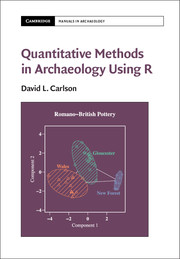19 - Conclusions
from PART III - ARCHAEOLOGICAL APPROACHES TO DATA
Published online by Cambridge University Press: 22 July 2017
Summary
In the preceding chapters we have explored some of the ways quantitative analysis of archaeological data can help us to understand the past. In particular, we have used the R Project for Statistical Computing. Since R is a collaborative project, new packages have been added or updated as you were reading this book. By now, you should have the ability to evaluate statistical hypotheses, explore your data for new, interesting patterns, and find ways to communicate those patterns to others.
Analyzing data begins with a research design that should inform decisions about how to collect the data, how much to collect, and how to analyze the data collected. Analysis of the data involves trying many different approaches. It is not a matter of clicking on a few menus and scanning generically produced output. Do not assume that using quantitative methods on your data will be any easier than the process of excavating or analyzing the data was. Ask interesting questions of your data: where it came from, how it got there, what it was used for, what it means. Then find the methods that get you closer to answering those questions. You will need multiple methods, not one, and if they lead to conflicting conclusions, you will need to wrestle with that fact.
Quantitative methods help us make some progress in answering the big questions I posed in Chapter 1. But you may have to learn a new way to use those methods. Traditional inferential statistics encourages you to think in terms of collecting statistically significant results and to measuring your progress in those terms. In working with archaeological data, I have tried to show that engaging with data is a process and that a simple tabulation of hypothesis tests is insufficient. As soon as you have data, you should begin looking at it, checking for errors, checking for unexpected distributions and patterns, and adjusting your research accordingly. Evaluate your findings in terms of multiple lines of information. For example, shape can be compared to spatial or temporal distribution. Site distribution can be compared to assemblage variability and so on.
- Type
- Chapter
- Information
- Quantitative Methods in Archaeology Using R , pp. 412 - 414Publisher: Cambridge University PressPrint publication year: 2017



